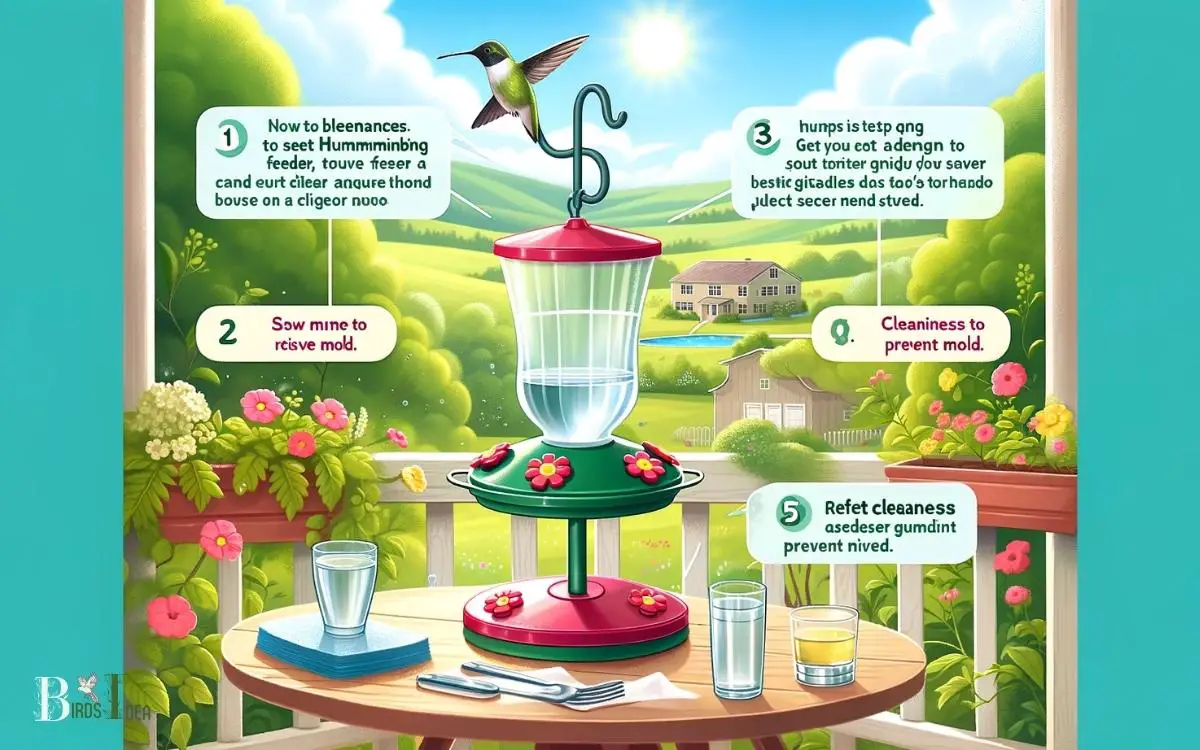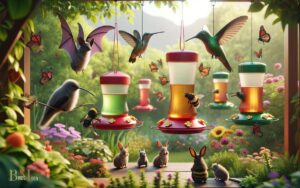How to Prevent Mold in Hummingbird Feeders? 7 Easy Steps!
To prevent mold in hummingbird feeders, it is essential to clean the feeders regularly with hot water and vinegar or a mild bleach solution, change the nectar frequently, especially in hot weather, and ensure proper feeder placement in a shaded area to inhibit mold growth.
Mold thrives in warm, wet environments, which can quickly arise in hummingbird feeders if they are not properly maintained.
Here are key steps to prevent mold buildup:
Employ vigilant feeder care to create a safe and welcoming haven for hummingbirds, deterring mold and ensuring avian health.

Key Takeaway
Step 1: Choosing the Right Feeder Design
Selecting the appropriate feeder design is crucial in providing a suitable environment for hummingbirds to feed while minimizing the risk of mold growth.
Opt for feeders with wide openings to allow for easy cleaning and refilling. Look for designs that are easy to disassemble, as thorough and regular cleaning is essential to prevent mold.
Additionally, choose feeders made of materials like glass or plastic, as these are easier to clean and less likely to develop mold compared to porous materials like wood.
The feeder should also have perches for the birds to rest while feeding. By selecting the right feeder design, you can ensure a healthy and inviting space for hummingbirds to feed while reducing the risk of mold contamination.
Now, let’s delve into selecting the ideal location for the feeder.
Step 2: Selecting the Ideal Location
After choosing the right feeder design, it is essential to consider the ideal location for placing the hummingbird feeder to provide a safe and attractive feeding environment.
When selecting a location, opt for areas with partial shade to protect the nectar from spoiling too quickly in the sun, but with enough visibility for both you and the hummingbirds to enjoy the view.
Additionally, choose a spot that is easily accessible for cleaning and refilling, preferably close to natural food sources such as flowers or trees.
It is important to ensure that the feeder is placed at a safe distance from windows to prevent collisions, ideally within 3 feet and close to cover for escape from predators.
By carefully selecting the location, you can create a welcoming and secure environment for these delightful birds.
Step 3: Regular Cleaning and Maintenance
Regular cleaning and maintenance are crucial for keeping hummingbird feeders mold-free. Proper cleaning techniques and an effective maintenance schedule are key to ensuring the health and safety of the hummingbirds that visit your feeder.
By implementing these practices, you can create an inviting environment for the birds while also preventing the growth of mold and bacteria.
Proper Cleaning Techniques
Implementing thorough cleaning and regular maintenance is essential for preventing mold in hummingbird feeders. To clean the feeder, start by disassembling all parts and discarding any remaining nectar.
Use a solution of one part white vinegar to four parts water to thoroughly clean all components, including the bottle, base, and feeding ports.
A small brush, such as a bottle brush or pipe cleaner, can be helpful for dislodging any stubborn mold or debris.
Rinse the feeder with hot water and allow it to air dry completely before refilling. It’s important to repeat this cleaning process every three to five days, especially in warm weather when mold is more likely to develop.
By diligently following these proper cleaning techniques, you can ensure a safe and healthy environment for the hummingbirds visiting your feeder.
Effective Maintenance Schedule
To maintain a mold-free environment in hummingbird feeders, it is crucial to establish a consistent cleaning and maintenance schedule.
Regular cleaning, ideally at least once every three to five days, is essential for preventing mold growth.
Start by thoroughly rinsing the feeder with hot water, using a small brush to scrub away any residue.
Ensure that all parts, including the feeding ports and perches, are completely dry before refilling the feeder with fresh nectar.
In addition to regular cleaning, it’s important to inspect the feeder for any signs of wear and tear, such as cracks or leaks, and promptly address any issues.
By adhering to a strict maintenance schedule, you can ensure a safe and healthy environment for the hummingbirds that visit your feeder.
We will discuss the use of mold-inhibiting solutions to further prevent mold growth.
Step 4: Using Mold-Inhibiting Solutions
Hummingbird enthusiasts can effectively prevent mold by regularly using mold-inhibiting solutions in their feeders.
These solutions are specifically designed to deter the growth of mold and keep the nectar fresh for longer periods, ensuring the health and well-being of the hummingbirds.
Here is a helpful table to compare some popular mold-inhibiting solutions:
| Solution Name | Active Ingredients |
|---|---|
| Hummzinger Guard | Citric Acid, Sodium Benzoate |
| Nectar Defender | Potassium Sorbate, Sodium Benzoate |
| First Nature Clear | Propylene Glycol |
| Perky-Pet Clear | Citric Acid, Sodium Benzoate |
Step 5: Optimal Food and Nectar Preparation
To ensure the optimal preparation of food and nectar for hummingbird feeders, it is crucial to start by cleaning feeding solutions thoroughly to prevent mold growth.
Additionally, using fresh nectar is essential to provide the best possible nutrition for the hummingbirds and reduce the risk of mold contamination.
These points are vital for maintaining the health of the hummingbirds and preventing mold in the feeders.
Clean Feeding Solutions Thoroughly
When preparing food and nectar for hummingbird feeders, it is essential to clean the feeding solutions thoroughly to prevent mold growth and ensure the optimal health of the hummingbirds.
To achieve this, follow these steps:
- Disassemble the feeder: Take apart all the components of the feeder, including the bottle, base, and perches.
- Wash with hot, soapy water: Use a mild detergent and a bottle brush to scrub all parts of the feeder thoroughly.
- Rinse with clean water: Ensure that all soap residue is completely removed from the feeder.
- Allow to air dry: After cleaning, let all parts air dry before refilling the feeder with fresh nectar.
Use Fresh Nectar
Proper preparation of fresh nectar is essential for maintaining the optimal health of hummingbirds.
To ensure the well-being of these delightful creatures, it is crucial to use a solution of four parts water to one part sugar.
Boil the water to remove impurities and then stir in the sugar until it dissolves. Let the nectar cool before filling the feeder.
It is important to replace the nectar every 2-3 days, especially in hot weather, to prevent fermentation and mold growth.
Additionally, thoroughly clean the feeder each time you refill it to prevent any build-up of harmful bacteria.
By following these steps, you will provide the best care for the hummingbirds that visit your feeder, ensuring their health and happiness.
Step 6: Proper Feeder Placement and Sunlight Exposure
Feeder placement and sunlight exposure are crucial factors in preventing mold in hummingbird feeders.
To ensure proper feeder placement and sunlight exposure, consider the following:
- Hang the feeder in a shaded area to prevent direct sunlight from causing the nectar to spoil quickly.
- Choose a location that is sheltered from rain and wind to prevent moisture buildup inside the feeder.
- Position the feeder where it receives the morning sun to help warm the nectar and discourage mold growth, but avoid prolonged exposure to hot afternoon sun.
- Regularly monitor the feeder’s location throughout the day to ensure it maintains the right balance of sunlight and shade.
Is Using Apple Cider Vinegar an Effective Method to Prevent Mold in Hummingbird Feeders?
Using apple cider vinegar for cleaning hummingbird feeders can be an effective method to prevent mold. Its acidic nature can help kill any mold spores and inhibit their growth. Simply mix a solution of apple cider vinegar and water, soak the feeder for a few minutes, and rinse thoroughly. This natural and affordable solution ensures a mold-free environment for our feathered friends.
Step 7: Addressing Leaks and Drips
To address leaks and drips in hummingbird feeders, it is essential to ensure that the feeder is tightly sealed and free from any cracks or damage that could lead to moisture accumulation.
Regularly inspect the feeder for any signs of wear and tear, focusing on the seams and connections. Tighten loose components and replace any worn-out parts to maintain a secure seal.
Additionally, consider using feeders with built-in ant moats to prevent leaks caused by insects or debris clogging the feeding ports.
When cleaning the feeder, pay close attention to the seals and gaskets, ensuring that they are free from mold and debris that could compromise their effectiveness.
By addressing leaks and drips promptly, you can effectively prevent mold growth and provide a clean, healthy environment for the hummingbirds.
Conclusion
Preventing mold in hummingbird feeders requires careful consideration of feeder design, location, cleaning, and maintenance.
Using mold-inhibiting solutions and preparing optimal food and nectar are also essential. Proper placement and addressing leaks and drips can further contribute to mold prevention.
Investigating the truth of these preventative measures can provide a deeper understanding of their effectiveness in maintaining a mold-free hummingbird feeder.






